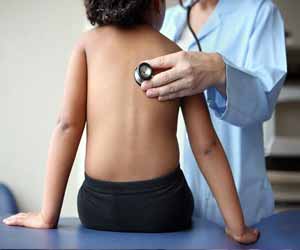- Home
- Editorial
- News
- Practice Guidelines
- Anesthesiology Guidelines
- Cancer Guidelines
- Cardiac Sciences Guidelines
- Critical Care Guidelines
- Dentistry Guidelines
- Dermatology Guidelines
- Diabetes and Endo Guidelines
- Diagnostics Guidelines
- ENT Guidelines
- Featured Practice Guidelines
- Gastroenterology Guidelines
- Geriatrics Guidelines
- Medicine Guidelines
- Nephrology Guidelines
- Neurosciences Guidelines
- Obs and Gynae Guidelines
- Ophthalmology Guidelines
- Orthopaedics Guidelines
- Paediatrics Guidelines
- Psychiatry Guidelines
- Pulmonology Guidelines
- Radiology Guidelines
- Surgery Guidelines
- Urology Guidelines
Mucocutaneous inflammatory lesions in children linked to Mycoplasma pneumoniae

Switzerland: Mucocutaneous disease occurs commonly in children with Mycoplasma pneumoniae community-acquired pneumonia (CAP) than in children with CAP of other origins, finds a recent study.
The findings, published in the journal JAMA Dermatology, suggests that mucocutaneous disease is a frequent manifestation of M pneumoniae infection in children and is associated with increased systemic inflammation, morbidity, and a higher risk of long-term sequelae.
In the study mucocutaneous disease was defined as any eruptive lesion that involved skin and/or mucous membranes occurring during the CAP episode.
The diagnosis of M. pneumoniae infection as the cause of the mucocutaneous disease is challenging because current diagnostic tests are not able to differentiate M pneumoniae infection from the carriage. Patrick M. Meyer Sauteur, University Children’s Hospital Zurich, Zurich, Switzerland, and colleagues examined the frequency and clinical presentation of M pneumoniae–induced mucocutaneous disease in children with CAP using improved diagnostics.
The study included 152 children aged 3 to 18 years with CAP enrolled in a CAP study from May 1, 2016, to April 30, 2017, at the University Children’s Hospital Zurich. Children were inpatients or outpatients with clinically defined CAP according to the British Thoracic Society guidelines. Data analysis was performed from July 10, 2017, to June 29, 2018.
Frequency and clinical presentation of M pneumoniae–induced mucocutaneous disease in childhood CAP. Mycoplasma pneumoniae infection was diagnosed by polymerase chain reaction (PCR) of oropharyngeal samples and confirmed with the measurement of specific peripheral blood IgM antibody-secreting cells by enzyme-linked immunospot assay to differentiate M pneumoniae–infected patients from carriers with CAP caused by other pathogens.
Key findings of the study include
- Among 152 enrolled children with CAP, 44 (28.9%) tested positive for M pneumoniae by PCR; of these, 10 children (22.7%) developed mucocutaneous lesions.
- All 10 patients with mucocutaneous eruptions tested positive for specific IgM antibody-secreting cells.
- Skin manifestations were found in 3 cases (2.8%) of M pneumoniae PCR-negative CAP (P < .001).
- The spectrum of M pneumoniae–induced mucocutaneous disease included M pneumoniae–induced rash and mucositis (3 cases [6.8%]), urticaria (2 cases [4.5%]), and maculopapular skin eruptions (5 cases [11.4%]).
- Two patients had ocular involvement as the sole mucosal manifestation (bilateral anterior uveitis and nonpurulent conjunctivitis).
- Patients with M pneumoniae–induced mucocutaneous disease had longer duration of prodromal fever (median [interquartile range], 10.5 [8.3-11.8] vs 7.0 [5.5-9.5] days) and higher C-reactive protein levels (median [interquartile range], 31 [22-59] vs 16 [7-23] mg/L) than patients with CAP due to M pneumoniae without mucocutaneous manifestations.
- They were also more likely to require oxygen (5 [50%] vs 1 [5%]), to require hospitalization (7 [70%] vs 4 [19%]), and to develop long-term sequelae (3 [30%] vs 0).
"These findings can guide intermediate- and long-term management, including surveilling for sequelae and precluding incorrect labeling of severe medication allergy," concluded the authors.
The study, "Frequency and Clinical Presentation of Mucocutaneous Disease Due to Mycoplasma pneumoniae Infection in Children With Community-Acquired Pneumonia," is published in the journal JAMA Dermatology.

Disclaimer: This site is primarily intended for healthcare professionals. Any content/information on this website does not replace the advice of medical and/or health professionals and should not be construed as medical/diagnostic advice/endorsement or prescription. Use of this site is subject to our terms of use, privacy policy, advertisement policy. © 2020 Minerva Medical Treatment Pvt Ltd